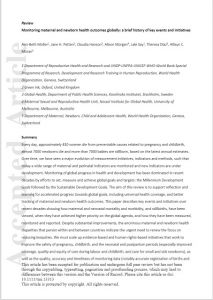
Every day, approximately 810 women die from preventable causes related to pregnancy and childbirth, almost 7000 newborns die and more than 7000 babies are stillborn, based on the latest annual estimates. Over time, we have seen a major evolution of measurement initiatives, indicators and methods, such that today a wide range of maternal and perinatal indicators are monitored and new indicators are under development.
Monitoring of global progress in health and development has been dominated in recent decades by efforts to set, measure and achieve global goals and targets: the Millennium Development Goals followed by the Sustainable Development Goals. The aim of this review is to support reflection and learning for accelerated progress towards global goals, including universal health coverage, and better tracking of maternal and newborn health outcomes.
This paper describes key events and initiatives over recent decades showing how maternal and neonatal mortality and morbidity, and stillbirths, have been viewed, when they have achieved higher priority on the global agenda, and how they have been measured, monitored and reported. Despite substantial improvements, the enormous maternal and newborn health disparities that persist within and between countries indicate the urgent need to renew the focus on reducing inequities.
We must scale up evidence-based and human-rights-based initiatives that work to improve the safety of pregnancy, childbirth, and the neonatal and postpartum periods (especially improved coverage, quality and equity of care during labour and childbirth, and care for small and sick newborns), as well as the quality, accuracy and timeliness of monitoring data (notably accurate registration of births and deaths).